| Black Wound Badge 1939 | |||
|---|---|---|---|
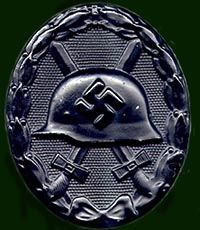 |
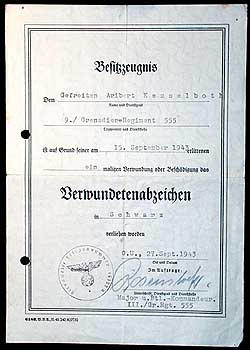 | ||
| Wound Badge in Black | Wound Badge in Black Document | ||
| Wound Badge 1939 |
Having closed the Condor Legion Wound Badge, Hitler reestablished the Wound Badges on the eve of World War II to recognize those individuals who were wounded in action with the enemy. The reinstitution decree stated that it was...
All members of the Armed Forces, Police units, and from 1943 on all civilians injured during allied air raids were eligible for the award. Those individuals killed in action were posthumously awarded the gold grade, which was presented to the next of kin. Because the World War I Wound Badges were still readily available at the time, these were initially once again modified by adding a swastika onto the helmet. There are some differences between these and the Condor Legion Wound Badge, however, as the swastika is not as high, has rounder, softer edges, and is not flushed with the helmet. These are referred to as “Spanish Type” or 1939 1st Type, but they are not to be confused with the Condor Legion Wound Badge. Though only used “temporarily” until the new version became available, this type was presented as late as 1942.“..as a mark of honor for all risked their lives for the Fatherland and have been wounded or maimed."
A few months after Operation Fall Weiss began the 1939 Wound Badge 2nd type
was available and started to be presented. This version, very similar to its
predecessors, was oval with pebbling on the background plate and featured an M35
helmet with a mobile swastika on it. Behind the helmet were the usual crossed
swords, and a wreath of laurels surrounding the badge with a ribbon at the base.
There are slight variations in the measurements of the badges, but the 24
authorized manufacturers were mostly consistent in size. The Wound badge was
presented with a standard document.
| Black Wound Badge 1939 | |||
|---|---|---|---|
 |
 | ||
| Wound Badge in Black | Wound Badge in Black Document | ||
The black grade was stamped from sheet brass, later steel, and was painted
mat or semi-mat. It has a hollow back with a needle pin. They were rarely
stamped (15-20%) with a makers mark, but if one was present it would be on the
reverse. Because of the decline in materials late war badges of this grade often
tended to rust.
| Silver Wound Badge 1939 | |
|---|---|
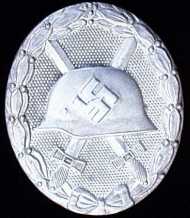 |
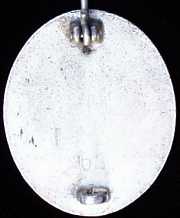 |
| Obverse | Reverse |
The Silver grade was produced initially from silver-plated brass, and later
in the war (1942) from whitewashed zinc. The reverse was solid, with either a
needle or fat bellied pin and the manufacturers and silver content marks, if
present. Awarded for three or four wounds, it could also be awarded for more
serious wounds if such wound included loss of hearing, a hand, a foot, an eye,
brain damage, or facial disfigurement.
| Gold Wound Badge 1939 | |
|---|---|
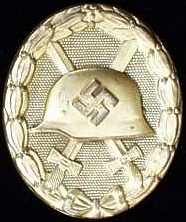 |
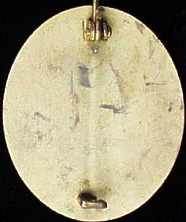 |
| Obverse | Reverse |
The gold grade was initially manufactured from gold plated or polished brass (as result of the polishing some of the badges lack pebbling and are almost flat). The reverse was again solid with the same pin characteristics and marks as the Silver grade. It was awarded for five or more wounds, and was also awarded for serious wounds in cases of total blindness or total disability. It should be noted that both Silver and Gold badges were also made from gilt-washed zinc as the war progressed. By 1945, as quality became less important and materials scarce, some black badges were being painted the appropriate color and issued as both silver and gold grades. In these cases the reverse is almost always hollow.
The Wound Badge could be presented either in a presentation case or an
envelope. The Silver and Gold grade were normally, though not always, presented
in a case and the Black grade was commonly presented in an envelope. The cases,
which were similar to the ones used by other awards such as the Iron Cross, were
made of wood and covered in simulated leather. The LDO logo was sometimes
stamped on the outside of the lid and the inside base was covered by flocked
material while the inside of the lid was covered with white satin. The envelopes
came with the name and class of the award written in gothic script. The
recipient was also presented witha document bearing the proper official
signatures and stamps. All badges were worn on the left pocked of the uniform
below any other decorations.
| Main | Imperial | Spanish | 20th July | Recipients |
| Main Page | Iron Cross | German Cross | War Merit Cross | Wound Badges | War Badges |
| Campaign Awards | Service Awards | Honor Awards | Axis Allies | Collectors Corner | Online Forum |